In this chapter, we will dive deeper into the key components and the implementation details of genetic algorithms, in preparation for the following chapters, where we will use genetic algorithms to create solutions for various types of problems.
First, we will outline the basic flow of a genetic algorithm, then break it down into its different components while demonstrating various implementations of selection methods, crossover methods, and mutation methods. Next, we will look into real-coded genetic algorithms, which facilitate search in a continuous parameter space. This will be followed by an overview of the intriguing topics of elitism, niching, and sharing in genetic algorithms. Finally, we will study the art of solving problems using genetic algorithms.
At the end of this chapter, you will have achieved the following...


